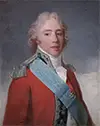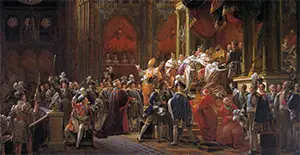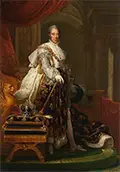The French King Charles X
Charles X was King of France for a handful of years in the first half of the 19th century. He gave up his throne in the wake of the July Revolution of 1830. He was born on Oct. 9, 1757, at the Palace of Versailles. His father was Louis, the Dauphin of France, and his mother was Maria Josepha of Saxony. His two older brothers were both named Louis, and they were both King of France, Louis XVI (1754–1793) and Louis XVIII (1814–1824). 
Charles married Princess Maria Teresa of Savoy on Nov. 16, 1773. They had four children. Charles was a good friend of Marie Antoinette, the wife and queen of King Louis XVI, and spent much time with her at her private retreat, the Petit Trianon. One of the interests they shared was lavish spending. Charles was not alone in this. Louis XVI had to spend enormous sums to pay off the debts of both of his younger brothers. When an armed group of protesters stormed the Bastille in July 1789, Charles took his family to Savoy, from whence his wife hailed, and then went to various other places in Europe, among them Koblenz, from which he and Louis planned an invasion in support of their brother, the king. That invasion never materialized. When Louis XVI was killed, Charles and family went to Great Britain. King George III gave the family a regular amount of money and permission to stay at the Palace of Holyroodhouse in Edinburgh. Charles was in the United Kingdom, as Great Britain had become in 1800, when his surviving older brother Louis arrived, in 1807. Charles's son Louis Antoine had married Louis's daughter Marie Thèrése. The brothers took control of the kingdom when Napoleon Bonaparte abdicated, in March 1814. Louis declared himself King Louis XVIII, and Charles was Lieutenant General of the Kingdom. They were out of power when Napoleon returned, during the Hundred Days, but Louis took control again after Napoleon's second and final abdication, and this began the Bourbon Restoration. Charles signed the armistice on behalf of France. 
When Louis was firmly on the throne, he sought to pursue a middle course, preserving many of the liberties won by the Revolution while also satisfying many of the concerns of the royalists, many of whom had been disenfranchised, forced to leave the country, and/or relieved of their personal fortunes. He ran into increasingly fierce opposition to this from a large group known as the ultra-royalists, with whom Charles increasingly sympathized. He played a larger and larger political role after 1820, when the ultra-royalists gained control of the Chamber of Deputies. When Louis XVIII died, on Sept. 16, 1824, Charles succeeded him as King. He chose the ceremony of consecration in the Cathedral of Reims, echoing the practice followed by the earliest of the French monarchs and signaling that he was to be a much more autocratic ruler than his brother had been. King Charles X began by granting amnesty to political prisoners and doing away with censorship. However, at heart he had the famous Sun King, Louis XVI, in mind and so pursued a strategy reminiscent of absolutism. Also among the initial legislation implemented by Charles through Prime Minister Jean-Baptiste de Villéle was a payment to nobles who had lost their lands to the Revolution. In the late 1820s as well, France suffered through a series of really bad harvests, resulting in grain and food shortages. Bowing to pressure from his nobles, Charles maintained a high tariff on grain, which resulted in even worse conditions for a large part of the population. Despite support from a number of rich nobles, Charles found himself increasingly out of favor with the rest of the population. Parliamentary elections in 1827 resulted in a majority opposed to the king's plans. He went through a series of prime ministers as well, the last one being Jules de Polignac, who kept Parlement on the sidelines until March 1830. By that time, French troops had occupied Algiers, the capital of Algeria, as part of a military expedition there that was ostensibly to end the threat of Mediterranean piracy but was also intended to evoke former glories through foreign conquest. 
A mere three weeks into the new parliamentary session, the king called for elections, which resulted in a large number of people opposed to the king and his policies and actions. In the ensuing elections, in June, a majority were again in opposition to what the king wanted. On July 6, Charles suspended the constitution and then dissolved Parlement and called for new elections, to take place under a new electoral system; in addition, the king clamped down on printed criticism. Charles also enacted a law that proscribed the death penalty for acts of sacrilege performed in churches; this was part of an evolving strategy to reinstate the Catholic Church as the preeminent religious force in France. The leaders of the Revolution had downplayed religion as a whole and diminished the power, wealth, and holdings of the Church. Napoleon had restored Catholicism to favor with the Concordat of 1801, and both Louis XVIII and Charles X advanced the cause of Catholicism. The number of people who wanted change by this time was quite high, and riots began. Thus began the July Revolution. On July 27, police shut down all newspapers. The following day, people erected barricades in the streets. Four days later, the king took his family and his court to Versailles. Charles abdicated the throne on Aug. 2, 1830. He named not his son but his grandson, Henri, Duke of Bordeaux, as his successor. The king's cousin, Louis Philippe, had other ideas and proclaimed himself King of the French. Charles, meanwhile, left France altogether, landing back in the U.K. and back at the Palace of Holyroodhouse. Greeting them this time around was an air of hostility: They had to adopt fake names in order to satisfy the requirement of the U.K. Prime Minister, the Duke of Wellington, that they enter the country as private citizens, and Charles styled himself the Count of Ponthieu. In 1832, they moved to another royal residence, Prague Castle, staying there until the death of Austrian Emperor Franz I, in 1835. That same year, Charles went to the Mediterranean coast. He was in Görz when he caught cholera. He died of that disease at Strassoldo Palace on Nov. 6, 1836. He was buried in what is now Slovenia; he remains the only French king not buried on French soil. |
|
Social Studies for Kids
copyright 2002–2024
David White




